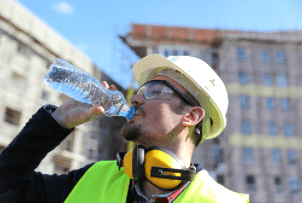Australian summers are hot, and a lot of us have jobs where we are required to be outside such as construction workers, farmers and even jobs that require a lot of travel in the car. As well as being sun smart, we all also need to be aware of heat-related illnesses and how to combat these working in the heat.
What is heat-related illness?
According to safework.nsw.gov.au (2021), if the body has to work too hard to keep cool, it starts to overheat and a worker begins to suffer from heat-related illnesses. Heat related illness is a term used to describe a range of conditions, including:
- Dehydration;
- Fainting;
- Heat rash;
- Heat cramps;
- Heat exhaustion;
- Heat stroke;
What are some warning signs of heat-related illnesses?
- Extreme high body temperature
- Hot, dry skin
- Increased heart and respiration rates
- Throbbing headache, nausea and vomiting
- Weakness, fainting or dizziness
- Muscle cramps
- Dark-coloured urine
- Confused, hostile or seemingly intoxicated behaviour
- Pale or bluish skin colour
- Seizures or unconsciousness
How to manage heat-related illnesses:
What should you do if you or if you noticed somebody in your workplace suffering from heat-related illnesses?
- Medical help – onsite first aid or an ambulance if necessary
- Move to an air-conditioned environment or a cool, shaded area;
- Loosen or remove any unnecessary clothing;
- Drink plenty of cool water;
- Fan and spray with cool water;
How can you protect yourself from a heat-related illness?
- When possible, avoid working in hot areas with full sun;
- Take frequent breaks;
- Use sunscreen and reapply as directions state;
- Cover up with a long-sleeve shirt and hat;
- Increase fluid intake;
- Avoid alcohol and excessive caffeine;
- Reduce activity when exposed to heat;
- Use a buddy system to watch for symptoms;
How can employers protect their workers against heat stress?
- Train employees in heat stress awareness and first aid;
- Provide drinking water;
- Provide rest breaks and air conditioned rest areas;
- Post urine colour chart in washrooms to raise awareness about hydration;
- Use machines to reduce physical demands at work;
- Schedule most strenuous work to cooler times of the day;
